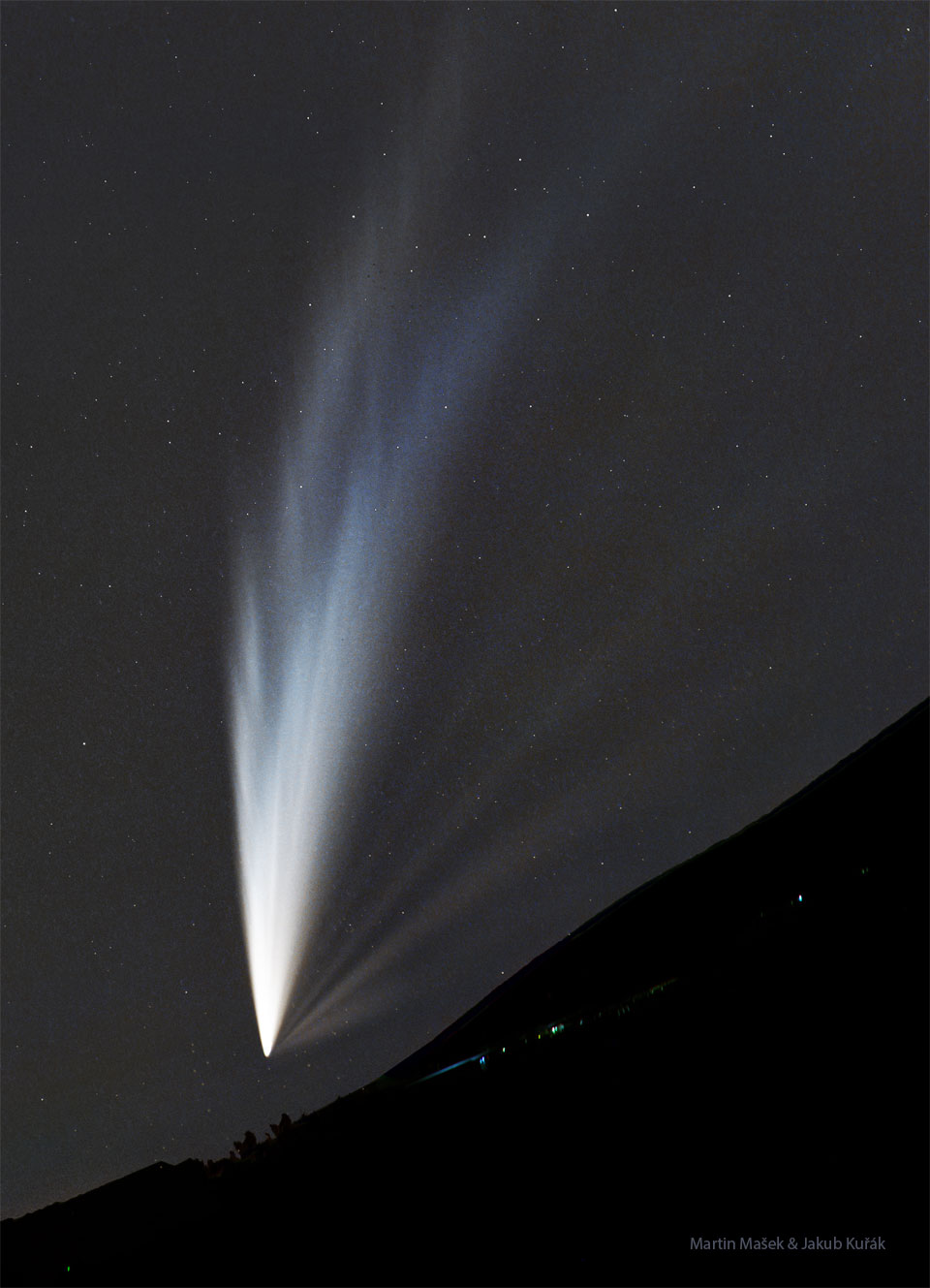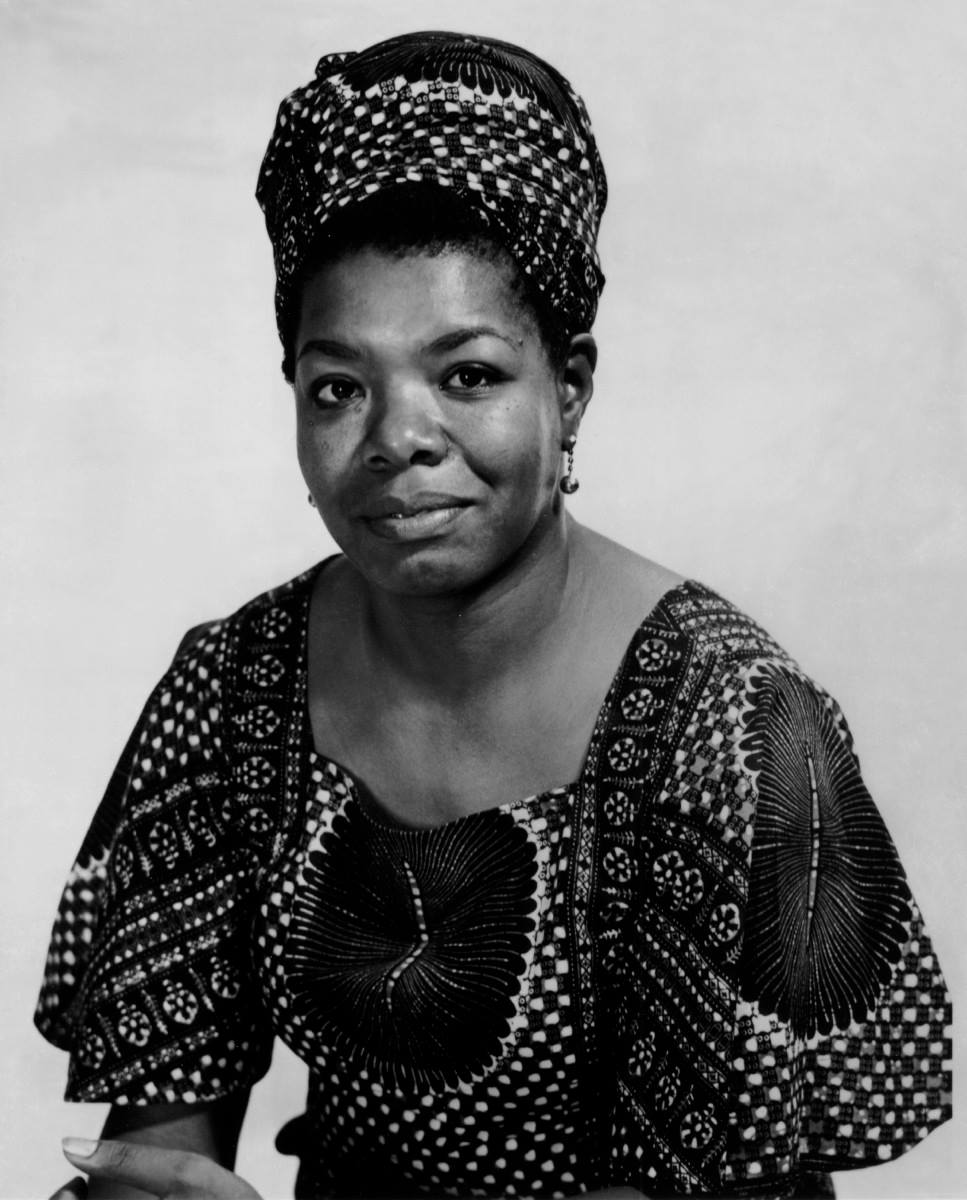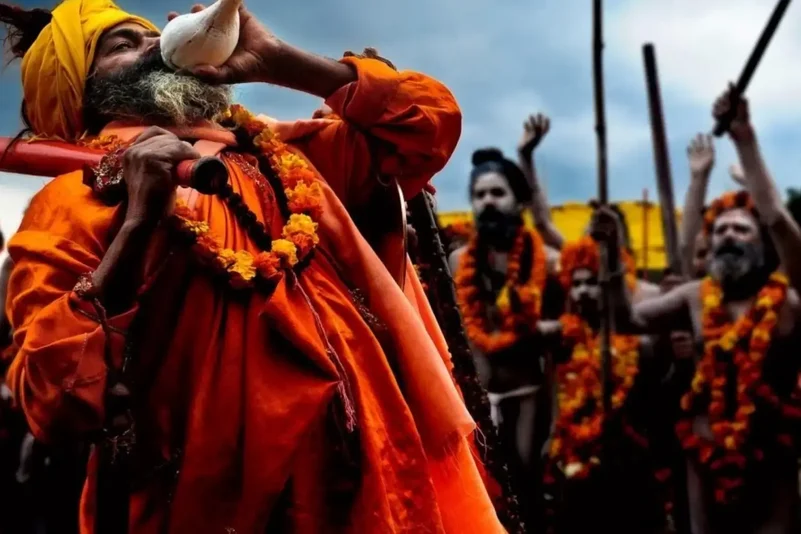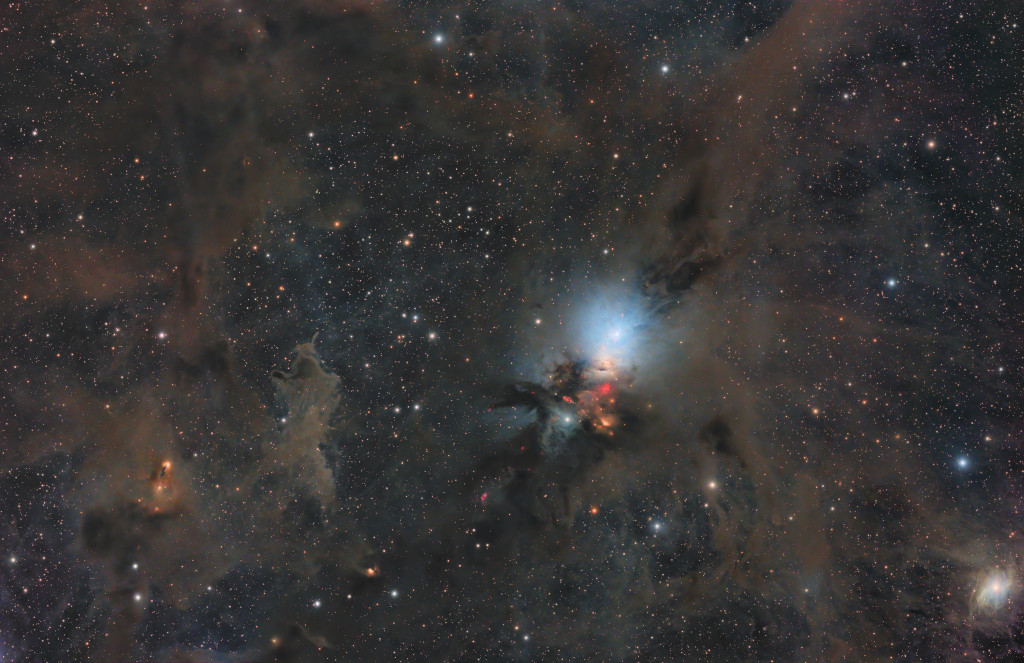Blog
C/2024 G3 (ATLAS) has developed several long and intricate tails visible from Earth’s southern hemisphere over the past two weeks. Many observers reported seeing the impressive comet without any optical aid above the western horizon just after sunset. At least six different tails appear in the featured image captured five days ago from the dark skies above Paranal Observatory in Chile. One possible cause for the multiple tails is dust and gas being expelled from the comet’s rotating nucleus. The outward push of the Sun‘s complex solar wind may also play a role. The huge iceberg-like nucleus of Comet ATLAS appears to have broken up near its closest approach to the Sun two weeks ago. Unfortunately, Comet ATLAS and its tails are expected to fade significantly over the coming weeks.

Huey Pierce “Piano” Smith (January 26, 1934 – February 13, 2023 NOLA) was an American R&B pianist and session musician whose sound was influential in the development of rock and roll.
His piano playing incorporated the boogie-woogie styles of Pete Johnson, Meade Lux Lewis, and Albert Ammons, the jazz style of Jelly Roll Morton and the R&B style of Fats Domino. Steve Huey of AllMusic noted that “At the peak of his game, Smith epitomized New Orleans R&B at its most infectious and rollicking, as showcased on his classic signature tune, “Rockin’ Pneumonia and the Boogie Woogie Flu“.
more...Clement Seymour “Coxsone” Dodd CD (26 January 1932 – 4 May 2004) was a Jamaican record producer who was influential in the development of ska and reggae in the 1950s, 1960s and beyond.
He was nicknamed “Coxsone” at school due to his talent as a cricketer (his friends compared him to Alec Coxon, a member of the 1940s Yorkshire County Cricket Clubteam).
more...Stéphane Grappelli (26 January 1908 – 1 December 1997) was a French jazz violinist. He is best known as a founder of the Quintette du Hot Club de France with guitarist Django Reinhardt in 1934. It was one of the first all-string jazz bands. He has been called “the grandfather of jazz violinists” and continued playing concerts around the world well into his eighties.
For the first three decades of his career, he was billed using a gallicised spelling of his last name, Grappelly, reverting to the Italian spelling Grappelli in 1969. The latter is used when referring to the violinist, including reissues of his early work.
more...

Clouds of stardust drift through this deep skyscape, across the Perseus molecular cloud some 850 light-years away. Dusty nebulae reflecting light from embedded young stars stand out in the nearly 4 degree wide field of view. With a characteristic bluish colorreflection nebula NGC 1333 is prominent near center. Hints of contrasting red emission from Herbig-Haro objects, the jets and shocked glowing gas emanating from recently formed stars, are scattered across the dusty expanse. While many stars are forming in the molecular cloud, most are obscured at visible wavelengths by the pervasive dust. The chaotic environment surrounding NGC 1333 may be similar to one in which our own Sun formed over 4.5 billion years ago. At the estimated distance of the Perseus molecular cloud, this cosmic scene would span about 80 light-years.

Jamesetta Hawkins (January 25, 1938 – January 20, 2012), known professionally as Etta James, was an American singer and songwriter. Starting her career in 1954, James frequently performed in Nashville’s famed R&B clubs, collectively known as the Chitlin’ Circuit, in the 1940s, 1950s, and 1960s. She sang in various genres, including gospel, blues, jazz, R&B, rock and roll, and soul, and gained fame with hits such as “The Wallflower” (1955), “At Last” (1960), “Something’s Got a Hold on Me” (1962), “Tell Mama“, and “I’d Rather Go Blind” (both 1967). She faced a number of personal problems, including heroin addiction, severe physical abuse, and incarceration, before making a musical comeback in the late 1980s with the album Seven Year Itch (1988).
James’s deep and earthy voice is considered to have bridged the gap between R&B and rock and roll. She won three Grammy Awards for her albums (2005 – Best Traditional Blues Album for Blues to the Bone; 2004 – Best Contemporary Blues Album for Let’s Roll; and 1995 – Best Jazz Vocal Performance, Female for Mystery Lady: Songs of Billie Holiday) and 17 Blues Music Awards. She was inducted into the Rock and Roll Hall of Fame in 1993, the Grammy Hall of Fame in 1999, and the Blues Hall of Fame in 2001. She also received the Grammy Lifetime Achievement Award in 2003.Rolling Stone magazine ranked James number 22 on its 2008 list of the “100 Greatest Singers of All Time”; she was also ranked number 62 in its list of the “100 Greatest Artists of All Time“. Billboard magazine’s 2015 list of the “35 Greatest R&B Artists Of All Time” also included James, whose “gutsy, take-no-prisoner vocals colorfully interpreted everything from blues and R&B/soul to rock n’roll, jazz and gospel.” The Rock and Roll Hall of Fame named her “one of the greatest voices of her century” and “forever the matriarch of blues.
more...Antônio Carlos Brasileiro de Almeida Jobim (25 January 1927 – 8 December 1994), also known as Tom Jobim
, was a Brazilian composer, pianist, guitarist, songwriter, arranger, and singer. Considered as one of the great exponents of Brazilian music, Jobim merged samba with cool jazz in the 1960s to create bossa nova, with worldwide success. As a result, he is regarded as one of the fathers of bossa nova, and as one of the most-celebrated songwriters of the 20th century.
Jobim was a primary force behind the creation of the bossa nova style, and his songs have been performed by many singers and instrumentalists internationally since the early 1960s.
In 1965, the album Getz/Gilberto was the first jazz record to win the Grammy Award for Album of the Year. It also won Best Jazz Instrumental Album – Individual or Group and Best Engineered Album, Non-Classical. The album’s single “Garota de Ipanema (The Girl from Ipanema)“, composed by Jobim, has become one of the most recorded songs of all time, and the album won the Record of the Year. Jobim composed many songs that are now included in jazz and pop standard repertoires. “Garota de Ipanema” has been recorded over 240 times by other artists. His 1967 album with Frank Sinatra, Francis Albert Sinatra & Antônio Carlos Jobim, was nominated for Album of the Year in 1968.
more...
Moses “Whispering” Smith (January 25, 1932 – April 28, 1984) was an American blues harmonicist and singer. He recorded tracks including “A Thousand Miles from Nowhere” and “Texas Flood” and worked with Lightnin’ Slim and with Silas Hogan. He was inducted into the Louisiana Blues Hall of Fame.
Smith was born in Union Church, Mississippi.
In the 1960s, Smith played harmonica on recordings by the swamp blues notables Lightnin’ Slim and Silas Hogan, before he was able to record some tracks of his own. At this time he worked with the record producer J. D. “Jay” Miller, based in Crowley, Louisiana, and his recordings were released by Excello Records. His singles included the songs “Mean Woman Blues”, and “Don’t Leave Me Baby” and the B-sideinstrumental tracks “Live Jive” and “Hound Dog Twist”.
more...Floyd George Smith (January 25, 1917 – March 29, 1982), sometimes credited as Floyd “Guitar” Smith, was an American jazz guitarist and record producer.
Born in St. Louis, Missouri, Smith studied music theory as a teenager and learned ukulele as a child before taking up guitar. He spent his early career in territory bands, playing in groups such as Eddie Johnson‘s Crackerjacks, the Jeter-Pillars Orchestra, the Sunset Royal Orchestra, the Brown Skin Models, and Andy Kirk‘s 12 Clouds Of Joy. His composition “Floyd’s Guitar Blues”, recorded with Andy Kirk’s orchestra in March 1939, has been claimed as the first hit record to feature a blues solo on electric guitar.
more...Benny Golson (January 25, 1929 – September 21, 2024 Philadelphia) was an American bebop and hard bop jazz tenor saxophonist, composer, and arranger. He came to prominence with the big bands of Lionel Hampton and Dizzy Gillespie, more as a writer than a performer, before launching his solo career. Golson was known for co-founding and co-leading The Jazztet with trumpeter Art Farmer in 1959. From the late 1960s through the 1970s Golson was in demand as an arranger for film and television and thus was less active as a performer, but he and Farmer re-formed the Jazztet in 1982.
Many of Golson’s compositions have become jazz standards, including “I Remember Clifford“, “Blues March“, “Stablemates“, “Whisper Not“, “Along Came Betty”, and “Killer Joe”. He is regarded as “one of the most significant contributors” to the development of hard bop jazz, and was a recipient of a Grammy Trustees Award in 2021.
more...John Adam Estes (January 25, 1899 or 1900 – June 5, 1977), known as, was an American blues guitarist, songwriter and vocalist. His music influenced such artists as the Beatles, Bob Dylan and Led Zeppelin.
Estes was born in Ripley, Tennessee, either in 1899 (the date on his gravestone) or 1900 (the date on his World War I draft card).[3] In 1915, his father, a sharecropper who played guitar, moved the family to Brownsville, Tennessee. Not long after, Estes lost the sight in his right eye when a friend threw a rock at him. At the age of 19, while working as a field hand, he began to perform professionally, mostly at parties and picnics, with the accompaniment of Hammie Nixon, a harmonica player, and James “Yank” Rachell, a guitarist and mandolin player. Estes continued to work on and off with both musicians for more than fifty years. He also performed in medicine shows with Willie Newbern.
At the suggestion of Jim Jackson, Estes made his debut as a recording artist in Memphis, Tennessee, in 1929, at a session organized by Ralph Peer for Victor Records. He recorded the tracks “Drop Down Mama” and “Someday Baby Blues” with Nixon in 1935. He later worked with Son Bonds and Charlie Pickett. He went on to record for Decca Records and Bluebird Records, with his last prewar recording session taking place in 1941. He made a brief return to recording at Sun Studio in Memphis in 1952, recording “Runnin’ Around” and “Rats in My Kitchen”, but otherwise was out of the public eye in the 1940s and 1950s.
more...More Posts
- The Cosmos with NGC 1569
- Charles McPherson Day
- Billy Taylor Day
- World Music with La Refrescante Banda Aljibe
- Daily Roots with Freddie McGregor
- The Cosmos with NGC 3359
- L. Subramaniam Day
- Steve Lacy Day
- World Music with Los Ruphay
- Daily Roots with Playing for Change
- The Cosmos with Berkeley 59
- Al Di Meola Day
- Junior Cook Day
- World Music with Deepak Ram
- Daily Roots with Bunny Wailer
- Performing with Soul Tight Committee 7-21-18
- The Cosmos with LL Pegasi
- Cat Stevens Day
- Sonny Clark Day
- World Music with Bamba Wassoulou Groove
